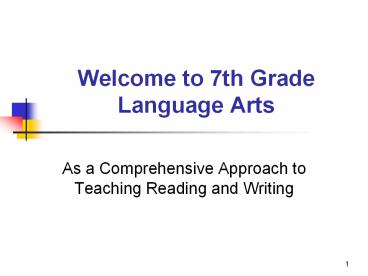Welcome to 7th Grade Language Arts - PowerPoint PPT Presentation
1 / 17
Title: Welcome to 7th Grade Language Arts
1
Welcome to 7th Grade Language Arts
- As a Comprehensive Approach to Teaching Reading
and Writing
2
Components of Balanced Literacy
- Reading
- Read Aloud
- Shared Reading
- Guided Reading
- Independent Reading
- Writing
- Modeled Writing
- Shared Writing
- Guided Writing
- Independent Writing
- Word Work
3
Read Aloud
- Teacher reads selection aloud to students.
- Demonstrates proficient reading
- Expands access to text beyond childs abilities
- Supports vocabulary development and demonstrates
comprehension strategies - Exposes students to a variety of genres
4
Shared Reading
- In a large group, the teacher
- extends students understanding of
- the reading process by reading from
- an enlarged text. After the initial
- reading, the teacher provides
- opportunities for the students to join
- in rereading the text.
5
Shared Reading continued
- Engages children through
- Activating background knowledge
- Explaining concepts and vocabulary
- Modeling and teaching decoding and comprehension
strategies - Questioning
- Coaching
- Providing specific feedback
6
Guided Reading
- The teacher uses (appropriately leveled text
or leveled text matched to students
instructional levels)to guide small groups of
students with similar instructional needs through
the reading process.
7
Guided Reading continued
- The teacher
- Identifies lesson objectives
- Provides a clear introduction to the text through
questioning and discussion - Coaches 1 to 2 children students individually in
problem solving while group reads silently - Reinforces word solving and comprehension
strategies
8
Guided Reading continues
- The students
- Read with teacher support available
- Practice decoding, comprehension and
self-regulating strategies - Discuss, reflect and reread to achieve the
lessons objectives - Build independence and confidence
9
Independent Reading
- Students read independently.
- Allows student to choose the text
- Provides practice at each students independent
level - Extends experiences with a variety of written
texts - Promotes reading for enjoyment and information
10
Word Work
- The teacher uses systematic and explicit
instruction throughout the balanced literacy
components to teach - Phonological and phonemic awareness
- Phonics
- Encoding and decoding strategies
- Word solving strategies for comprehension
11
Modeled Writing
- The teacher models proficient writing.
- Demonstrates proficient writing
- Expands access to written language beyond
students abilities - Exposes students to a variety of genres
12
Shared Writing
- Teacher and students collaborate to compose
text which the teacher scribes. - Models writing strategies
- Teaches writing strategies
- Extends understanding of the writing process
- Provides a vehicle for students to explore how
text is structured to convey meaning
13
Guided Writing
- The teacher guides small groups of students
and/or individuals through the writing process.
14
Guided Writing continued
- The teacher
- Monitors students writing strategies
- Reinforces and introduces writing skills as
necessary - Engages students through questioning and specific
feedback
15
Guided Writing continued
- The students
- Write with teacher guidance
- Practice writing strategies
- Explore a variety of genres
- Build independence and confidence
16
Independent Writing
- Students write independently.
- Allows student to choose the topic and genre
- Provides meaningful practice at each students
independent level - Values the time dedicated to the writing process
17
Research
- Reading volume predicted reading comprehension
in third-, fifth-, eighth- and tenth-grade
students, even when pupil factors such as past
reading achievement, prior knowledge and
motivation were controlled statistically. - Guthrie, J.T., Wigfield, A., Metsala, J., Cox,
K. 1999. Motivational and Cognitive Predictors
of Text Comprehension and Reading Amount.
Scientific Studies of Reading , 3(3), 231-256.































